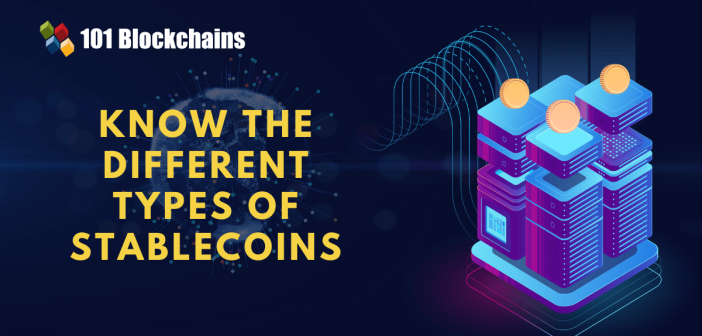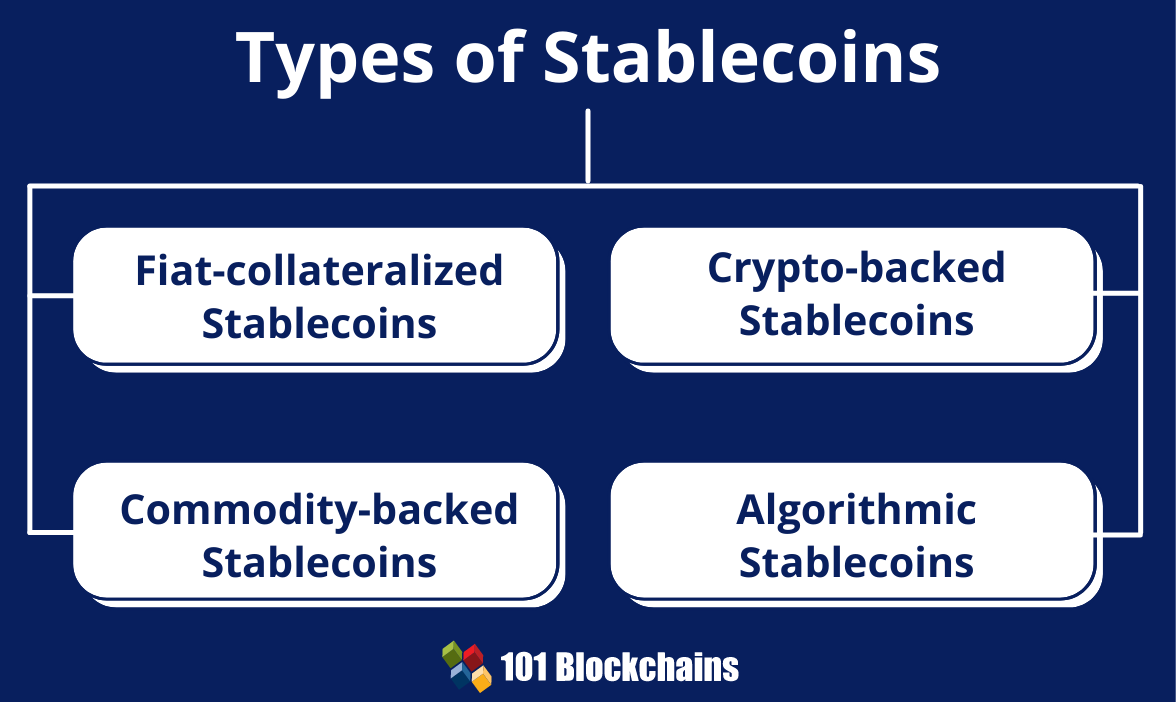Master stability in a volatile world — unlock the power of stablecoins to navigate crypto with confidence. Explore real-world use cases in the Stablecoins Mastery course.

- Cryptocurrency
Gwyneth Iredale
- on October 01, 2021
What are the Different Types of Stablecoins?
Stablecoins have been around for some time, and now the world is getting to know them. The attention around stablecoins is not limited only to the crypto community. Traditional market investors, as well as regulators, are looking into the prospects of leveraging stablecoins. Therefore, the demand for comprehensive information regarding the different stablecoin types has been skyrocketing in recent times.
Stablecoins are just cryptocurrencies with their value pegged against some stable assets such as precious metals or fiat currencies such as the US Dollar. The different stablecoin categories are basically indicative of the assets backing them. A detailed understanding of the different types of stablecoins could help you establish promising foundation-level knowledge on stablecoins.
Want to learn the basic and advanced concepts of stablecoins? Enroll Now in Stablecoin Fundamentals Masterclass
Understanding the Need for Stablecoins
Why did we need stablecoins in the first place? The answer to this question can provide the best way to start exploring more about the types of stablecoin. It is quite clear that the value of money shifts directions in various ways beyond explanation. The value of currency generally depends on the strength of the economy, thereby presenting formidable risks for everyone’s finances. Generally, people look for investment in precious metals, valuable assets, or exclusive real estate for preservation of their wealth.
The arrival of cryptocurrencies marked the introduction of completely new financial instruments. Crypto assets such as Ethereum and Bitcoin could present high levels of volatility, thereby calling for instruments to boost stability. Subsequently, the demand for stablecoins escalated in recent years with profound growth since July 2017. Stablecoins offers the most reliable solution for hedging funds in event of extremely volatile crypto prices.
Just like in the case of any emerging asset class, cryptocurrencies have also been subject to the influence of market forces. Various types of crypto projects are currently identifying methods for reducing risk and fostering participation in the wider crypto ecosystem. The different stablecoin types showed the possibilities of integrating stability directly in the crypto assets.
Curious about the Ethereum Technology ? Enroll now: The Complete Ethereum Technology Course
Why Should I Know about Stablecoin Variants?
The interest in learning about ‘what are the different types of stablecoins?’ also relates largely to the profound market downturns. The massive levels of volatility in the crypto world noted recently have been responsible for increasing the demand for stablecoins. As of now, the largest stablecoin, i.e., Tether or USDT, has a market value of almost $58 billion. The second-largest stablecoin in the crypto economy, USD Coin or USDC, holds a market value of almost $15 billion. So, you can clearly anticipate the popularity levels of stablecoin and the reasons for eagerness to discover more about stablecoin categories.
Different Types of Stablecoins
One thing you must know about stablecoins is that they are digital currencies on the blockchain ecosystem. It is possible to recognize stablecoins by the collateral structures backing them. You can find four different types of collateral structures for stablecoin, which establish the basis for types of stablecoin.
Based on the underlying collateral structure, you can find the following types of stablecoins –
1. Fiat-collateralized Stablecoins
Fiat-collateralized stablecoins are the foremost variant of stablecoins you would come across. They have the backing of a fiat currency such as Euro, GBP, or the US Dollar. Fiat-collateralized stablecoins are the simplest stablecoin types with a 1:1 ration backing. The 1:1 ration implies that one stablecoin would be equal to one unit of currency such as a dollar or one Euro.
Therefore, every fiat-backed stablecoin has real fiat currency in a bank account for backing it up. Users can redeem their coins as the entity managing the stablecoin takes the corresponding amount of fiat currency from their reserve and sends it to the user’s bank account. At the same time, the equivalent amount of stablecoins are taken out of circulation or destroyed.
Fiat-backed stablecoins are one of the simplest stablecoin categories due to their structural advantage. Simplicity offers the most valuable advantage for beginners to understand cryptocurrencies in a better way. Therefore, fiat-backed stablecoins could have a huge role in encouraging the large-scale adoption of stablecoins. The stability of the country’s economy ensures limited fluctuation in the value of stablecoin.
2. Commodity-backed Stablecoins
The second entry in answers to ‘what are the different types of stablecoins?’ brings the limelight on commodity-backed stablecoins. As the name clearly implies, commodity-backed stablecoins have the backing of different types of interchangeable assets such as precious metals. The most common commodity used as collateral for commodity-backed stablecoins is gold.
In addition, you could also find many other stablecoins with the backing of assets such as real estate, oil, and precious metals other than gold. The owners of commodity-collateralized stablecoins basically exercise ownership over a tangible asset with real value. This is a formidable advantage over the majority of cryptocurrencies.
The commodities generally offer possibilities for appreciating in value over the course of time. As a result, such types of stablecoin tend to offer better incentives for people holding and using commodity-backed stablecoins. Furthermore, commodity-collateralized stablecoins also enable the possibility for anyone in the world to invest in precious metals such as gold.
Traditionally, such commodities were restricted only to the financially privileged class. However, commodity-backed stablecoins create new opportunities in investment for the average person, irrespective of geography.
Want to learn blockchain for free? Enroll Now: Enterprise Blockchains Fundamentals
The most common example of commodity-backed stablecoin refers to Digix Gold or DGX. It is basically an ERC-20 token developed on the Ethereum network with the backing of physical gold. Digix Gold shows the perfect illustration of commodity-backed stablecoin types by pegging one DGX against one gram of gold. The gold remains in reserve in Singapore while undergoing audits for a period of three months to ensure transparency.
Users also have the flexibility of redeeming physical bars of gold by visiting the reserve in Singapore. Other examples of commodity-collateralized stablecoins include the Tiberius Coin or TCX and the SwissRealCoin or SRC. Tiberius Coin has the backing of not one but a combination of seven different precious metals. On the other hand, SRC has the backing of a portfolio of Swiss real estate.
3. Crypto-backed Stablecoins
Well, this may seem a bit out of place when you think of cryptocurrencies backing up stablecoins. What about the volatility of cryptocurrencies? How can you expect stability in stablecoins which are backed by cryptocurrencies? As a matter of fact, crypto-collateralized stablecoins offer better decentralization in comparison to fiat-collateralized stablecoins. In addition, stablecoins are generally over-collateralized for absorbing price fluctuations as collateral. Let us try to understand the crypto-backed types of stablecoin with an example.
Assume that you have to deposit almost $1000 worth of Ether for obtaining $500 worth of stablecoins. Therefore, you can see that stablecoins are 200% collateralized, thereby implying the possibility of enduring a price drop of 25%. After the price drop, you would still have the $500 worth of stablecoins, albeit with the backing of $750 worth of Ether. If the price of cryptocurrency collateral drops considerably, then stablecoins will be automatically subject to liquidation.
The most crucial trait you can identify in this entry among stablecoin categories is decentralization. Crypto-backed stablecoins could help processes become more trustless with improved security and better transparency. Without any single entity in control of your funds, you have the benefit of decentralization.
Furthermore, certain crypto-backed stablecoins also have the backing of multiple cryptocurrencies for ensuring efficient risk distribution. Additionally, crypto-backed stablecoins also have the advantage of improved liquidity. However, crypto-collateralized stablecoins are one of the most complex stablecoin types in use right now.
4. Algorithmic Stablecoins
The final addition among stablecoin categories would take us to non-collateralized or algorithmic stablecoins. Non-collateralized or algorithmic stablecoins do not have any assets or collateral for backing them. So, how are algorithmic stablecoins classified as stablecoins when they don’t have any collateral for backing them up?
The non-collateralized or algorithmic stablecoins follow an algorithm for controlling the stablecoin supply. Such a type of approach is also known as seignorage shares. With the rise in demand, new stablecoins will be created to reduce the price to the normal level. In event of considerably low coin trading, coins on the market are purchased up for reducing circulating supply.
Basically, algorithmic stablecoins could offer stability according to the tenets of market supply and demand. In addition, it is also important to note that algorithmic stablecoins feature the highest level of decentralization and independence. On the other hand, such algorithmic types of blockchain depend on continual growth for ensuring success. You should know that there is no collateral involved with algorithmic stablecoins for liquidity, and everyone can lose their money in case of a crash.
Want to become a certified blockchain professional? Enroll Now: Certified Enterprise Blockchain Professional (CEBP)
Bottom Line
The different stablecoin types clearly showcase the various ways in which stablecoins could work. As of now, stablecoins are working with four distinct models which follow different collateral structures. The different types of collateral used for stablecoins define their types, such as fiat-backed, commodity-backed, crypto-backed, and non-collateralized stablecoins. Each stablecoin variant has its unique characteristic, i.e., the collateral for backing the stablecoin.
However, there are other subtle differences you can take note of. For example, crypto-backed stablecoins offer better liquidity, while fiat-backed stablecoins are easier to understand and use for beginners. Expand your knowledge of stablecoins with an in-depth reflection on the world of stablecoins and their different variants.
*Disclaimer: The article should not be taken as, and is not intended to provide any investment advice. Claims made in this article do not constitute investment advice and should not be taken as such. 101 Blockchains shall not be responsible for any loss sustained by any person who relies on this article. Do your own research!






